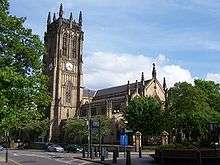Robert Dennis Chantrell
| Robert Dennis Chantrell | |
|---|---|
 | |
| Born |
1793 Newington, Southwark, London. |
| Died | 1872 |
| Nationality | English |
| Occupation | Architect |
| Buildings | Leeds Parish Church |
Robert Dennis Chantrell (Newington, Surrey 14 January 1793 – Norwood, 4 January 1872) was an English church architect, best-known today for designing Leeds Parish Church.
Career
Chantrell was born in Newington, Southwark, London. He was a pupil in the office of Sir John Soane from 1807 to 1814, and in 1819 he started a practice in Leeds.
At the beginning of his career he designed a string of classical buildings. After a few years, he reinvented himself as a pioneering Gothic specialist to meet the huge demand of the times for additional Church accommodation.
He became one of the most accomplished specialists in this area of practice and numerous remaining building testify his original skills. The crowning of his career was the building of Leeds Parish Church (1837-1841), the biggest church in England since Christopher Wrens's St Paul's and, on a national level, the most important church of the age.
After he moved to London, Chantrell started a second career as surveyor of church constructions. He also became a respected antiquary, writer, lecturer and member of several prestigious London committees.
Architectural work
Surviving buildings by Chantrell include:
- alterations to the Leeds Library, including galleries (1821–36)
- completion of Rudding Park House (c1824)
- alterations to St Mary-the-Virgin, Hunslet (1826)
- St Stephen, Kirkstall (1828-9)
- Emmanuel Church, Lockwood (1828-9)
- All Saints, Netherthong (1828-9)
- St Peter, Morley (1829–30)
- St Matthew, Holbeck (1829–32)
- partial reconstruction of All Saints, Pontefract (1832-3)
- St Peter, Leeds (Leeds Parish Church) (1837–41)
- Christ Church, Skipton (1837-9)
- Christ Church, Lothersdale (1838)
- St Wilfred, Pool-in-Wharfedale (1839)
- the steeple of Holy Trinity, Boar Lane, Leeds (1839)
- the neo-roman tower of the St. Salvator's Cathedral in Bruges, (Belgium) (1839)
- the neo-Norman bellcote of St John the Baptist, Adel (1839)
- St David, Holmbridge (1839–40)
- St Lucius, Farnley Tyas (1840)
- Holy Trinity, Batley Carr (1841-2)
- St Paul, Shadwell (1841-2)
- St Mary, Honley (1843)
- Holy Trinity, Leven (1843)
- St Paul, Denholme Gate (1843-6, with Thomas Shaw)
- All Saints, Roberttown (1844-6, with Thomas Shaw)
- Holy Trinity, Cowling (1845)
- St Mary the Virgin's Church, Middleton, Leeds (1846–52)
- the tower of St Paul, Halifax (1847)
- St Andrew, Keighley (1847-8)
- St Paul, Armitage Bridge (1848)
Surviving buildings restored by Chantrell include:
- St Catherine, Barmby Moor, East Yorkshire (1852)[1][2]
Gallery


 Church of St Wilfrid in Pool-in-Wharfedale
Church of St Wilfrid in Pool-in-Wharfedale
Sources and Literature
| Wikimedia Commons has media related to Buildings by Robert Dennis Chantrell. |
- Howard COLVIN, Biographical Dictionary of English Architects 1660-1840, John Murray, London, 1954
- Nikolaus PEVSNER & Enid RADCLIFFE Yorkshire: The West Riding, 1959, 2nd edition 1967, Penguin Books, London
- Derek LINSTRUM, West Yorkshire Architects and Architecture, Lund Humphries Publishers, London, 1979, ISBN 0-85331-410-1
- Andries VAN DEN ABEELE & Christopher WEBSTER, Architect Robert D. Chantrell en de kathedraal van Brugge, 1987, Bruges
- Christopher WEBSTER, R.D. Chantrell, architect: his life and work in Leeds 1818–1847, Leeds, 1992
- Christopher WEBSTER & Andries VAN DEN ABEELE, A portentous mass of bastard romanesque frippery: an early ecclesiological export, Leeds, 1999.
- Susan WRATHMELL, & John MINNIS, Leeds, Pevsner Architectural Guides, Yale University Press, New Haven, CT, 2005, ISBN 0-300-10736-6
- Christopher WEBSTER, R. D. Chantrell (1793-1872) and the architecture of a lost generation, Reading, Spire Books, 2010, ISBN 978-1-904965-22-0.
- ↑ Yorkshire Gazette, Saturday 17 April 1852 p7 col.2: "The re-opening of St Catherine's Church, Barmby Moor"
- ↑ Historic England: Church of St Catherine 1083879 Note: restoration mistakenly attributed to J.B. Atkinson by Historic England